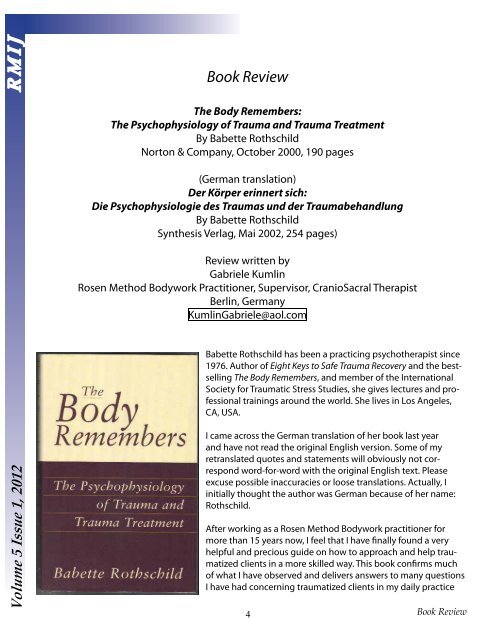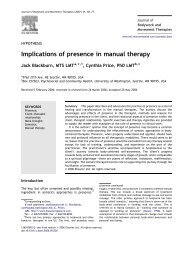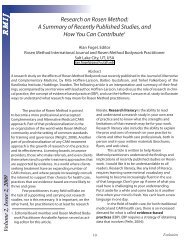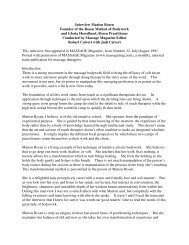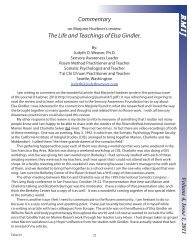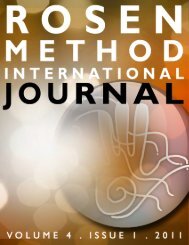R M I J ... - Rosen Journal
R M I J ... - Rosen Journal
R M I J ... - Rosen Journal
You also want an ePaper? Increase the reach of your titles
YUMPU automatically turns print PDFs into web optimized ePapers that Google loves.
R M I J . . .<br />
Book Review<br />
The Body Remembers:<br />
The Psychophysiology of Trauma and Trauma Treatment<br />
By Babette Rothschild<br />
Norton & Company, October 2000, 190 pages<br />
(German translation)<br />
Der Körper erinnert sich:<br />
Die Psychophysiologie des Traumas und der Traumabehandlung<br />
By Babette Rothschild<br />
Synthesis Verlag, Mai 2002, 254 pages)<br />
Review written by<br />
Gabriele Kumlin<br />
<strong>Rosen</strong> Method Bodywork Practitioner, Supervisor, CranioSacral Therapist<br />
Berlin, Germany<br />
KumlinGabriele@aol.com<br />
Babette Rothschild has been a practicing psychotherapist since<br />
1976. Author of Eight Keys to Safe Trauma Recovery and the bestselling<br />
The Body Remembers, and member of the International<br />
Society for Traumatic Stress Studies, she gives lectures and professional<br />
trainings around the world. She lives in Los Angeles,<br />
CA, USA.<br />
Volume 5 Issue 1, 2012<br />
I came across the German translation of her book last year<br />
and have not read the original English version. Some of my<br />
retranslated quotes and statements will obviously not correspond<br />
word-for-word with the original English text. Please<br />
excuse possible inaccuracies or loose translations. Actually, I<br />
initially thought the author was German because of her name:<br />
Rothschild.<br />
After working as a <strong>Rosen</strong> Method Bodywork practitioner for<br />
more than 15 years now, I feel that I have finally found a very<br />
helpful and precious guide on how to approach and help traumatized<br />
clients in a more skilled way. This book confirms much<br />
of what I have observed and delivers answers to many questions<br />
I have had concerning traumatized clients in my daily practice<br />
4 Book Review
over the years. I highly recommend Rothschild’s book to other <strong>Rosen</strong> practitioners, teachers, students or any<br />
others who work in the body-mind field. Although I am not a trauma therapist, I often encounter mildly or<br />
severely traumatized clients in my <strong>Rosen</strong> practice. This book is a valuable resource, not only for us practitioners<br />
but also for anyone interested in trauma recovery.<br />
Rothschild transmits to us in simple, easily comprehensible terms and language the newest results of neurobiological<br />
and neuroscientific research and relates how to convincingly carry them into practice. She<br />
explains in a simple manner the significance and relevance of the limbic system (our “survival center”), the<br />
purpose and function of the amygdala and hippocampus, the complexity of engraved traumatizing events,<br />
their processing possibilities as well as their psychosomatic effects and distinctive features. She gives valuable<br />
advice on how to build a confident, safe and responsible relationship with our clients, from the mildly<br />
to the severely traumatized.<br />
<strong>Rosen</strong> Method bodyworkers obviously have learned how to offer safe and confident surroundings. In this<br />
book, however, we get additional information about dissociations and flashbacks, how to avoid wrong<br />
tracks, how to separate past from present, and why to work initially with the after-effects of trauma. This<br />
confirms what we do in <strong>Rosen</strong> sessions. We have learned how to avoid “falling” into the past. Dissociations or<br />
flashbacks do easily happen and I find steering narration and verbal empathy to the NOW and PRESENT can<br />
prevent wrong tracks. Certainly we do not wish to DO much with our hands but keep them clear and quiet,<br />
at one place, simply supporting the person.<br />
We enter the tricky and complex network of the nervous system, the ANS (autonomic nervous system) and<br />
SomNS (somatic nervous system) in order to better understand how traumatized clients regain a feeling of<br />
embodiment, felt sense, body awareness and body sensations. Rothschild offers us a huge range of options<br />
with which we can enhance and increase body awareness. She extensively explains the somatic resources<br />
that interfere with a person’s psychology and illustrates to the practitioner how to connect with them and<br />
how to offer more resources, anchors, and bonding options through touch and substantiated verbal empathy.<br />
For both clinicians and their clients, there is tremendous value in understanding the psychophysiology of<br />
trauma and knowing how to deal with its manifestations. This book illuminates that physiology, shining<br />
a bright light on the impact of trauma on the body and the phenomenon of somatic memory. Research<br />
has shown that people who have been traumatized hold an implicit memory of traumatic events in their<br />
brains and bodies. That memory is often expressed in the symptomatology of posttraumatic stress disorder<br />
—nightmares, flashbacks, startle responses, and dissociative behaviors. In essence, the body of the traumatized<br />
individual refuses to be ignored.<br />
While reducing the chasm between scientific theory and clinical practice and bridging the gap between talk<br />
therapy and body therapy, Rothschild presents principles and non-touch techniques for giving the body<br />
its due. The somatic techniques are chosen with a view to making trauma therapy safer while increasing<br />
mind-body integration. Reading her case studies at the end of the book made me reflect more on my daily<br />
bodywork sessions and certainly inspired me and upgraded my skills with traumatized clients. As a result, I<br />
address my questions to the client in a more precise way, while at the same time keeping a clear distance. I<br />
choose anchors together with the client and affirm resources in the present, making her feel safe, accepted<br />
and seen. Also my touch has changed. I hold a person in one place only, staying there rather than touching<br />
at different places and keeping my hands relatively quiet. I make sure she feels absolutely safe, very often<br />
not even lifting the sheet.<br />
Kumlin<br />
5<br />
R M I J Volume 5, Issue 1, 2012
R M I J . . .<br />
This book enhances our knowledge of how the mind and body can together ease the after-effects of trauma.<br />
It is a gem for <strong>Rosen</strong> practitioners and other body-mind therapists. I hope to include some of this precious<br />
knowledge in my work as a supervisor and teacher in training.<br />
Thanks to Alan Fogel’s book and workshops on The Psychophysiology of Self-Awareness, many of us have had<br />
the chance to enter this amazingly interesting field. Without Alan’s initiation and impulse, I would probably<br />
not have looked for further literature on this subject. Babette Rothschild’s, The Body Remembers: Casebook,<br />
has also been highly praised by many trauma therapists and experts. It provides the reader with numerous<br />
examples of how multiple modalities can be blended to bring optimal healing to trauma survivors.<br />
I chose to quote Peter A. Levine PhD, author of Waking the Tiger, Healing Trauma and also from Piet Hein,<br />
Danish poet (1905 – 1996):<br />
“The Body Remembers Casebook extends Babette Rothschild’s earlier and widely read<br />
work, contributing to the growing acceptance of the central role of the body in the understanding<br />
and treatment of trauma. In particular, this second volume offers practitioners<br />
from all treatment modalities clear and specific guidelines for incorporating body oriented<br />
insights and practice. And, most meaningfully, Rothschild illuminates the important<br />
principle of facilitating clients in finding their own way towards wholeness.” (Quotation on<br />
B. Rothschild’s website, Therapy, 2012, Reviews) Somatic Trauma<br />
“The soul may be a mere pretense,<br />
the mind makes very little sense,<br />
so let us value the appeal<br />
of that which we can taste and feel.”<br />
---Piet Hein (Rothschild’s quotation in The Body Remembers, Chapter 6, page 148, German edition)<br />
Berlin, April 2012<br />
Volume 5 Issue 1, 2012<br />
6 Book Review


